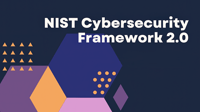
Over the years, the growing frequency of cyberattacks and data breaches has prompted lawmakers to establish robust cybersecurity laws and regulations. Compliance is a must to be regarded as a trustworthy and reliable company to do business with.
While the U.S. employs a sector-specific and state-based approach to cybersecurity, the European Union's General Data Protection Regulation (GDPR) offers a unified framework governing data privacy and cybersecurity across multiple countries. Although this guide focuses on U.S. laws, GDPR sets a global standard, especially for multinational corporations within and outside the United States.
Major U.S. Cybersecurity Regulations and Standards
U.S. cybersecurity regulations are designed to ensure proactive data protection, risk management, and incident reporting. By adhering to these laws, organizations can stay ahead of potential threats and demonstrate their proactive approach to cybersecurity.
CISA (Cybersecurity Information Sharing Act)
The Cybersecurity Information Sharing Act (CISA) facilitates cyber threat information sharing between private companies and the federal government. This enhances national security by fostering collaboration across sectors to better detect, prevent, and mitigate cyberattacks. Companies participating in CISA programs receive legal protections from liability when sharing threat information in good faith. The Cybersecurity and Infrastructure Security Agency (CISA), under the Department of Homeland Security (DHS), plays a vital role in this information exchange.
FISMA (Federal Information Security Management Act)
FISMA mandates federal agencies and their contractors, including cloud service providers, to secure information systems and protect federal data. It emphasizes continuous monitoring, risk management, and implementing security controls based on the National Institute of Standards and Technology (NIST) Cybersecurity Framework. Agencies and contractors must report their compliance efforts annually to ensure accountability and transparency.
CFAA (Computer Fraud and Abuse Act)
Enacted in 1986, the CFAA is a fundamental federal law for prosecuting cybercrimes. It criminalizes unauthorized computer access, enabling legal action against hackers and cybercriminals involved in data theft and ransomware attacks. Beyond criminal penalties, the CFAA allows victims to pursue civil actions for damages, offering businesses a means to recover losses from cyberattacks.
HIPAA (Health Insurance Portability and Accountability Act)
HIPAA establishes stringent security standards for the healthcare industry to protect Protected Health Information (PHI). Healthcare organizations, insurance companies, and their partners must implement physical, administrative, and technical safeguards to secure PHI. The Breach Notification Rule requires providers to notify affected individuals and the Office for Civil Rights (OCR) of any PHI breaches affecting more than 500 individuals within 60 days. Non-compliance can lead to fines ranging from $100 to $50,000 per violation.
GLBA (Gramm-Leach-Bliley Act)
The GLBA requires financial institutions to protect consumers' personal financial information. It includes the Privacy Rule, which mandates institutions explain their information-sharing practices, and the Safeguards Rule, which obliges them to implement a comprehensive information security program. Compliance involves regular evaluation of security controls, risk assessments, and adjusting data protection strategies. Non-compliance can result in fines, reputational damage, and civil lawsuits.
PCI-DSS (Payment Card Industry Data Security Standard)
Although PCI-DSS is not a federal law, it is a crucial industry standard to protect payment card information by setting security requirements for businesses handling cardholder data. Required by major credit card companies like Visa and Mastercard, non-compliance can lead to fines and loss of payment processing privileges. PCI-DSS specifies requirements such as encrypting sensitive data, using secure firewalls, and conducting regular vulnerability testing. E-commerce businesses and those processing high volumes of credit card transactions must meet PCI-DSS standards to avoid penalties and data breaches.
State-Level Cybersecurity Laws
Federal laws provide a baseline, but many states have enacted their own cybersecurity and privacy regulations, often offering greater consumer protections and stricter business requirements.
California Consumer Privacy Act (CCPA)
The CCPA grants California residents significant control over their personal information. It lets consumers know what data businesses collect about them, request deletion, and opt out of data sales. The CCPA applies to for-profit businesses meeting specific criteria, such as annual revenues over $25 million or handling data of 100,000 or more California residents. Non-compliance can result in fines of up to $7,500 per violation, and consumers can sue if their data is exposed due to inadequate security.
New York SHIELD Act
The SHIELD Act strengthens New York's data breach notification requirements and mandates appropriate security measures to protect personal information. It expands the definition of private information to include biometric records and login credentials. Businesses must adopt administrative, technical, and physical safeguards, such as employee training and intrusion detection systems. Non-compliance may lead to civil penalties and legal action from the state attorney general.
Variability in State Laws
Businesses operating across multiple states face challenges due to varying cybersecurity and data privacy laws. States like Massachusetts and Illinois have strong data protection laws, while others may be more lenient. This complexity has led to calls for a federal data privacy law to create a uniform standard similar to the GDPR in the EU.
Sector-Specific U.S. Laws and Compliance
Certain industries face unique cybersecurity challenges, necessitating sector-specific laws to secure sensitive information in high-risk areas like defense and energy.
Defense Industry: DFARS (Defense Federal Acquisition Regulation Supplement)
DFARS includes cybersecurity requirements for defense contractors working with the Department of Defense (DoD). Contractors must implement NIST SP 800-171 controls to protect Controlled Unclassified Information (CUI) and report cybersecurity incidents to the DoD. Compliance is critical for securing defense contracts; failure can result in disqualification from defense projects.
The Cybersecurity Maturity Model Certification (CMMC) adds accountability by requiring contractors to meet specific cybersecurity maturity levels based on the sensitivity of the information handled. With the necessary certification level, businesses can bid on defense contracts.
Energy Sector: NERC CIP (Critical Infrastructure Protection)
NERC CIP standards aim to protect the electrical grid and ensure the security of energy production and distribution systems. Organizations must implement robust security programs for physical and digital assets, including asset identification, vulnerability assessment, and incident reporting. Compliance is essential to avoid NERC penalties and protect the energy infrastructure from sophisticated cyberattacks.
Key Compliance Steps for U.S. Businesses
Navigating U.S. cybersecurity laws requires a proactive compliance approach involving technical safeguards and aligning policies with legal requirements.
Implementing a Cybersecurity Framework (NIST, ISO 27001)
Adopting recognized cybersecurity frameworks like NIST or ISO 27001 helps ensure compliance. These frameworks provide
- structured approaches to managing cybersecurity risks,
- focusing on identifying threats,
- protecting assets,
- detecting incidents,
- responding to breaches and recovery.
Continuous monitoring and improvement are emphasized to evolve cybersecurity practices with emerging threats.
Conducting Regular Risk Assessments and Audits
Regular risk assessments help identify vulnerabilities and evaluate security controls' effectiveness. Businesses can prioritize security investments based on the likelihood and impact of potential breaches. Security audits, conducted internally or by third parties, ensure policies are followed, and safeguards function correctly, demonstrating compliance with laws like HIPAA and PCI-DSS.
Data Encryption and Breach Response Planning
Encryption protects sensitive data in transit and at rest, making it unreadable without a decryption key. Laws like HIPAA and GLBA require data encryption to prevent unauthorized access. A well-defined breach response plan outlines steps for identifying, containing, and reporting cyber incidents. Federal and state laws mandate timely notification to affected individuals and authorities, making such plans essential for compliance and minimizing breach impact.
Training Staff on Security Policies
Employees are the first line of defense against cyber threats. Regular training on phishing awareness, password management, and data handling reduces human error risks. Industries with strict regulations often require employee training by law. For example, HIPAA mandates staff training on privacy and security policies.
U.S. Cybersecurity Incident Reporting Requirements
Reporting data breaches and cyber incidents is crucial to U.S. cybersecurity regulations, with obligations varying by law and industry.
Federal and State-Level Obligations
Federal laws like HIPAA and GLBA have strict reporting requirements. HIPAA's Breach Notification Rule mandates notifying affected individuals and the Department of Health and Human Services within 60 days of discovering a PHI breach. State laws like the CCPA and SHIELD Act also require businesses to notify residents when personal information is compromised. Failure to comply can result in substantial fines and legal penalties.
Breach Reporting Timelines
Reporting timelines differ across laws. HIPAA allows up to 60 days, while the GDPR requires reporting within 72 hours. Businesses operating internationally must be aware of these differences and comply with the strictest standards. Having a clear breach response plan helps meet reporting obligations efficiently.
Cyber Incident Response Best Practices
A robust incident response plan minimizes cyberattack impact and ensures legal compliance. It should detail steps for detecting, containing, and eradicating threats and recovery procedures. Establishing clear communication channels for reporting incidents to regulators, customers, and stakeholders is crucial. Regular simulations and employee training enhance response effectiveness.
Penalties for Non-Compliance
Non-compliance with U.S. cybersecurity laws can result in significant penalties, including fines, legal liabilities, and reputational damage.
Fines and Sanctions
Penalties vary by law and violation nature. HIPAA violations can incur fines from $100 to $50,000 per incident, with annual caps for repeated violations. The CCPA allows fines of up to $7,500 per intentional violation. Beyond financial penalties, businesses may suffer reputational harm, leading to lost trust and revenue.
Legal Liabilities for Breaches
The CFAA permits victims to sue entities responsible for unauthorized system access. Businesses failing to implement adequate security measures may face lawsuits from customers or partners after a breach. In some cases, non-compliance can lead to criminal charges, mainly if negligence results in significant harm.
U.S. vs. European Cybersecurity Laws
The U.S. and EU have distinct regulatory frameworks for cybersecurity and data privacy. The U.S. follows a sector-specific, state-based approach, while the EU employs a unified framework under the GDPR.
GDPR's Strict Data Privacy Requirements
The GDPR, effective since 2018, imposes strict rules on handling EU citizens' data regardless of the business location. It mandates data minimization, transparency, and accountability and requires explicit user consent for data collection. Individuals have the right to access, delete, and understand the use of their data. Non-compliance can result in fines up to €20 million or 4% of global annual revenue.
Comparison of U.S. and EU Approaches
U.S. laws are fragmented and often industry-specific, with varying state regulations like the CCPA and SHIELD Act. The EU's GDPR provides uniformity across member states, focusing on individual data rights. The lack of a comprehensive federal data privacy law in the U.S. creates complexity for businesses operating across states.
Impact on U.S.-Based Companies
U.S. companies dealing with EU citizens or operating internationally must comply with both U.S. and international regulations. The Schrems II ruling has necessitated alternative mechanisms, such as Standard Contractual Clauses, for cross-border data transfers following the invalidation of the Privacy Shield framework.
Future Trends in U.S. Cybersecurity Legislation
U.S. cybersecurity laws will likely adapt as cyber threats evolve, addressing current gaps and enhancing national readiness.
Emerging Threats and Lawmaking Influence
The rise in sophisticated cyberattacks, such as ransomware and supply chain breaches, has prompted legislative proposals for stricter regulations. Proposed laws may require businesses to disclose ransomware payments and strengthen defenses against supply chain attacks, underscoring the urgency for updated laws.
Predictions for New Federal Laws
Growing bipartisan support exists for a comprehensive federal data privacy law, potentially standardizing regulations across states and drawing from laws like the CCPA and GDPR. Proposed legislation may include mandatory cyber incident reporting, with requirements to notify authorities within specific timeframes, aligning with global standards.
Harmonization of State Laws or New Federal Frameworks
The complexity of navigating multiple state laws has led to calls for harmonization. A federal law could simplify compliance by providing national standards for data protection and breach notification. This would create a predictable regulatory environment and align the U.S. more closely with international standards, facilitating cross-border business operations.
Conclusion: Compliance Isn't a Luxury
Understanding the complex regulatory landscape enables businesses to secure their networks and sensitive data proactively.
Key compliance actions include
- adopting recognized cybersecurity frameworks,
- conducting regular assessments and audits,
- encrypting data, and
- implementing effective breach response plans.
As cyber threats and regulations evolve, prioritizing cybersecurity and compliance will reduce legal risks and enhance resilience against emerging threats. Staying informed about U.S. and international laws ensures businesses meet the strictest requirements when handling cross-border data.










